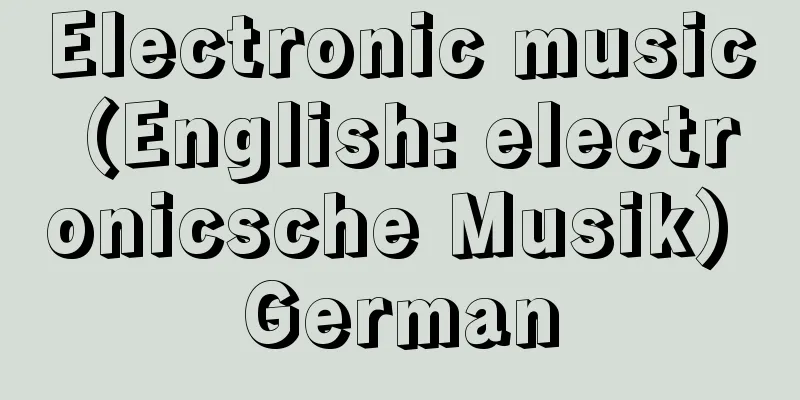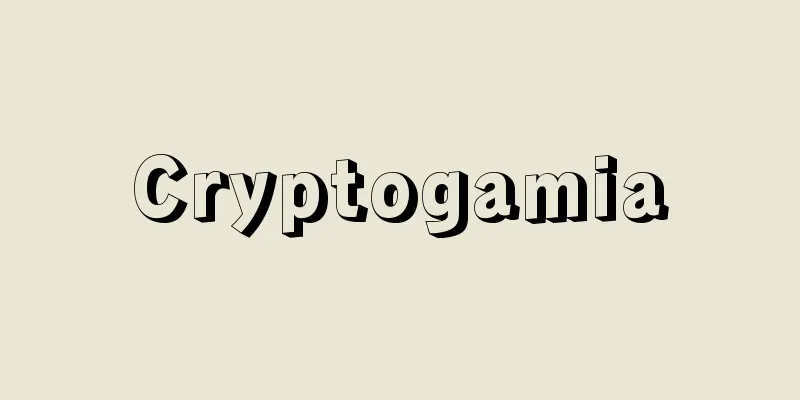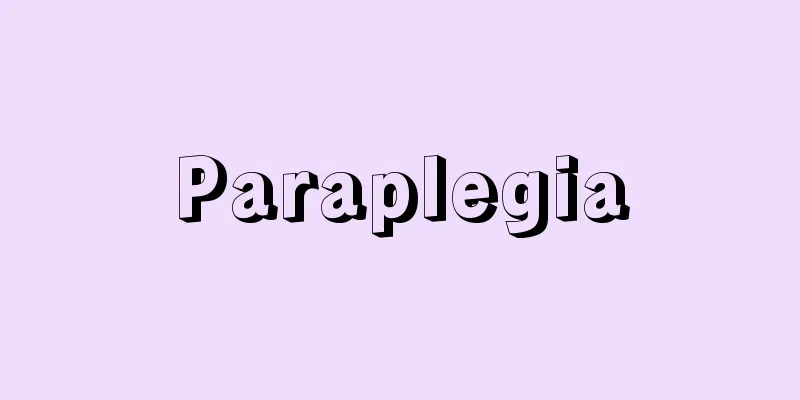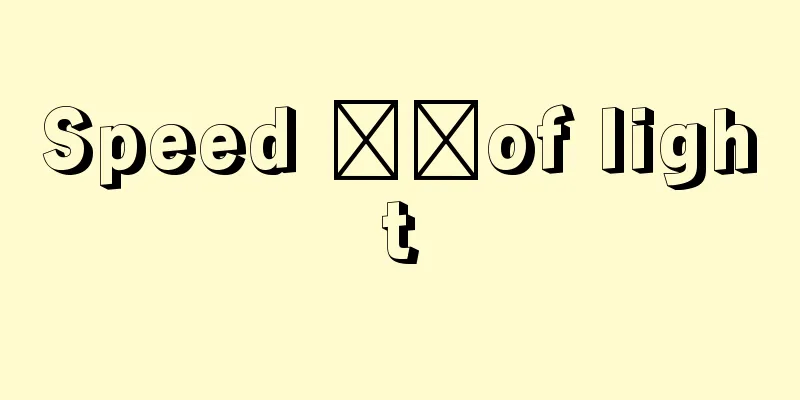Electronic music (English: electronicsche Musik) German

|
In a broad sense, it refers to all music made using electronic means, and in a narrow sense, it refers to music composed using electronic oscillators around the 1950s. Its founders were Herbert Eimert (1897-1972), who worked at a studio in Cologne, Germany, and Stockhausen. They adopted the name "electronic music" to distinguish it from "music concrète," which used concrete sounds as its material, created by Pierre Schaeffer (1910-1995) and others in France. In Stockhausen's "Studies I and II" (1953-1954), he used oscillators to generate pitches with a certain ratio like a tone sequence, expanding the theory of musique seriale. Inspired by this, electronic music studios were established in Munich, Brussels, Milan, Utrecht, Gravezano, Princeton University, the University of Illinois, and the NHK Studios in Tokyo. At NHK, Mayuzumi Toshiro's "Music of Sine Waves Based on the Ratio Series of Prime Numbers" (1955) was the first, followed by Moroi Makoto's (1930-2013) "Seven Variations" (1956), a collaboration between Mayuzumi and Moroi, Matsushita Shinichi's (1923-1990) "Black Monastery" (1959), and Moroi's "The Star of Pythagoras" (1959). The latter two pieces incorporate choirs, chamber music, and a narrator in addition to electronic sounds, and these hybrid works would eventually dominate over purely electronic music. The first example of this can be seen in "Junglied" (1955-1956), in which Stockhausen electronically modulated a boy's singing voice and layered it with purely electronic sounds. In the late 1950s, simultaneous performances of tape and live instruments were attempted in works such as Stockhausen's Kontakte (1959-1960) and Xenakis' Analogy A+B (1958-1959). Furthermore, live electronic music was born, in which electronic devices and tapes were actually manipulated on stage. These included Stockhausen's Mixture (1960) and Microphony I, II (1964-1965), which electronically transformed instrumental sounds, Cage's Cartridge Music (1960), which used electronic sounds other than instrumental sounds, Cage's Rozart Mix (1965), which manipulated recorded tapes on the spot, and Stockhausen's Solo (1965-1966), which used feedback circuits. Subsequent electronic music became polarized between those using huge equipment, such as those made by Stockhausen and Xenakis, and those using simple tabletop equipment, such as those made by Americans David Tudor and Takehisa Kosugi. Along with Cage, Tudor and Kosugi had also long participated in the performances of dancer Merce Cunningham. In addition to this lineage of pure sound generators, the trend of computer music cannot be overlooked. Since Neumann Gutmann's The Silver Scale (1957), computer-synthesized sounds have become increasingly complex. Since the 1970s, electronic devices with built-in computers and personal computers have become widespread, so "pure" electronic music without computer intervention has become rare. Furthermore, the invention of the drum machine and rhythm box in the mid-1970s brought electronic music closer to dance music, which developed into the major movement known collectively as electronica and techno in the 1990s, after passing through hip-hop and house in the 1980s. As a result, DJs (disc jockeys) as sound producers have come to feel closer to electronic music composers than to regular instrumentalists or composers. [Shuhei Hosokawa] "Electronic Music in Japan 1955-1981" by Yuji Tanaka (1998, ASCII) " "The World of Computer Sound" by Yoichi Nagashima (1999, CQ Publishing) " "Avant-Music Guide" by Shunichi Shiba (1999, Sakuhinsha) [References] | | | | | | | | | |Source: Shogakukan Encyclopedia Nipponica About Encyclopedia Nipponica Information | Legend |
|
広義には電子的手段を用いたすべての音楽、狭義には1950年代ごろ電子発振器を用いて構成された音楽をさす。ドイツのケルンのスタジオで働いていたアイメルトHerbert Eimert(1897―1972)、シュトックハウゼンらがその創始者である。彼らは、フランスのシェフェールPierre Schaeffer(1910―1995)らによる、具体音を素材とする「ミュージック・コンクレート」と区別するために、この「電子音楽」という名前を採用した。シュトックハウゼンの『習作Ⅰ、Ⅱ』(1953~1954)では、発振器で、ある比率をもった高さの音を音列のように用い、ミュージック・セリエルの理論を拡張した。 これに刺激され、ミュンヘン、ブリュッセル、ミラノ、ユトレヒト、グラベザーノ、プリンストン大学、イリノイ大学、東京のNHKスタジオなどに、次々と電子音楽スタジオが設立された。NHKでは黛敏郎(まゆずみとしろう)の『素数の比系列による正弦波の音楽』(1955)を皮切りに、諸井誠(もろいまこと)(1930―2013)と黛の共作『七のヴァリエーション』(1956)、松下真一(1923―1990)の『黒い僧院』(1959)、諸井の『ピュタゴラスの星』(1959)などがつくられた。最後の2曲は、電子音のほかに合唱、室内楽、語り手が加わっているが、純粋に電子的な音楽よりも、こうした混成作品のほうがやがて主流を占めるようになる。その最初の例は、シュトックハウゼンが少年の歌声を電子的に変調し、純電子音と重ね合わせた『少年の歌』(1955~1956)にみることができる。 そして1950年代後半には、テープと生(なま)楽器の同時演奏が、シュトックハウゼンの『コンタクテ』(1959~1960)や、クセナキスの『類比A+B』(1958~1959)などで試みられるようになる。さらに舞台上で実際に電子機器やテープを操作するライブ・エレクトロニック音楽が生まれた。これにはシュトックハウゼンの『混合』(1960)や『ミクロフォニーⅠ、Ⅱ』(1964~1965)のように楽器音を電子的に変形するもの、ケージの『カートリッジ・ミュージック』(1960)のように楽器音以外の音を電子的に利用するもの、ケージの『ローツァルト・ミックス』(1965)のように録音されたテープをその場で操作するもの、シュトックハウゼンの『ソロ』(1965~1966)のようにフィードバック回路を用いるもの、などがある。 その後の電子音楽は、一方でシュトックハウゼン、クセナキスに代表されるような巨大な装置を用いたもの、もう一方でアメリカのデビッド・テュードア、小杉武久ら卓上の簡単な装置を用いたものに両極化していった。テュードアと小杉はケージとともに、舞踏家マース・カニンガムのパフォーマンスにも長く加わっていた。 このような純粋な音響発生装置を用いた系譜のほかに、コンピュータ音楽(コンピュータ・ミュージック)の流れも見逃すことができない。ニューマン・グートマンの『銀の音階』(1957)以来、コンピュータによる合成音は複雑化の一途をたどっている。1970年代以降はコンピュータ内蔵の電子機器、パーソナルコンピュータなどが広く普及したため、コンピュータを介入させない「純粋な」電子音楽はむしろ稀(まれ)になっている。さらに、1970年代なかばのドラム・マシーン、リズム・ボックスの発明は、電子音楽とダンス・ミュージックを近づけることになり、1980年代のヒップ・ホップ、ハウスを経て、1990年代にはエレクトロニカ、テクノと総称される大きな動きに発展した。そのため、音響制作者としてのDJ(ディスク・ジョッキー)は、通常の楽器演奏家や作曲家よりも、かつての電子音楽作曲家に親近感を抱くようになった。 [細川周平] 『田中雄二著『電子音楽イン・ジャパン 1955~1981』(1998・アスキー)』▽『長嶋洋一著『コンピュータサウンドの世界』(1999・CQ出版)』▽『柴俊一著『アヴァン・ミュージック・ガイド』(1999・作品社)』 [参照項目] | | | | | | | | | |出典 小学館 日本大百科全書(ニッポニカ)日本大百科全書(ニッポニカ)について 情報 | 凡例 |
<<: Electronic circuit - denshikairo (English spelling) electronic circuit
>>: Electronic Organ - Denshi Organ
Recommend
roth fail
…These are figures related to the sun, which show...
Nasal allergy - bia-ru-gi (English spelling)
→Allergic rhinitis Source: Shogakukan Encyclopedi...
Shigella dysenteriae (English name) Shigelladysenteriae
…Shigella are gram-negative rods measuring 2-4 μm...
Devil stinger
A fish of the family Inimiidae. Generally speaking...
Process simulation
Simulating the behavior of chemical processes usin...
Petrucci, O. (English spelling) PetrucciO
...Motets, whose texts are based on a wide range ...
Salvage Convention - Kainankyuujojoyaku
...In addition, the Convention provides that anyo...
Transported soil
Soil that has developed from soft, unconsolidated ...
Seiko Corporation - Seiko
Founded in 1881 by Kintaro Hattori as Hattori Watc...
Christian Theology
A study that focuses on the content of Christian ...
Immunoglobulin - immunoglobulin
Also called immunoglobulin. A general term for pr...
visual angle
…The unit of visual acuity is determined by inter...
Wisdom - E
…In 1870, he married Mathilde Mautet, who was sun...
Activity level - activity
This is the effective value of concentration used...
Big-flowered plant - Big-flowered plant
...The flowers contain linalool, benzyl alcohol, ...








![Fujisawa [city] - Fujisawa](/upload/images/67ccb274405ea.webp)
